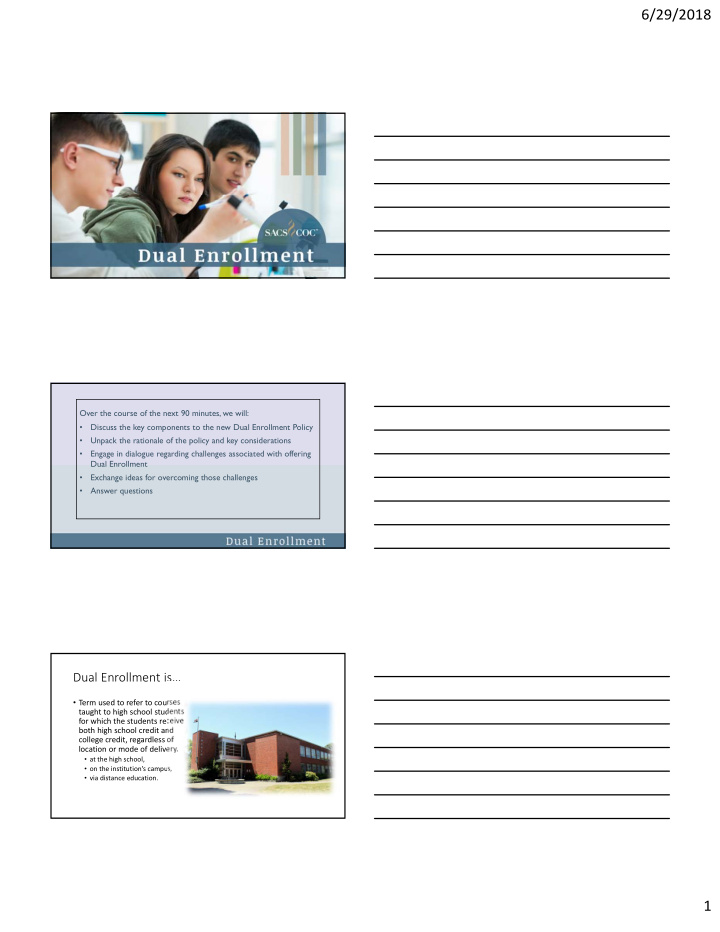



6/29/2018 Over the course of the next 90 minutes, we will: Discuss the key components to the new Dual Enrollment Policy • Unpack the rationale of the policy and key considerations • Engage in dialogue regarding challenges associated with offering • Dual Enrollment Exchange ideas for overcoming those challenges • Answer questions • Dual Enrollment is… • Term used to refer to courses taught to high school students for which the students receive both high school credit and college credit, regardless of location or mode of delivery. • at the high school, • on the institution’s campus, • via distance education. 1
6/29/2018 Dual Enrollment… • Also includes programs and courses that may be offered as “early college,” “dual credit,” or “concurrent enrollment.” Purpose of the New Policy Approved by Board of Trustees June 2018 bit.do/SACSCOCdual 2
6/29/2018 All Commission Principles and policies apply wi without out exc except ption to dual enrollment students, programs, and instructional sites. Substantive Change • Notification and prior approval (if needed) of off ‐ campus instructional sites where dual enrollment courses and programs are offered. • A site is a facility that is located physically apart from the main campus of the institution at which an institution offers instruction. 3
6/29/2018 A site is a site is a site, regardless of • What you call it • Who owns it • How many students are there • Whether the institution’s name is on the door • If students are required to be there, it is a site ‐‐ and subject to notification and approval. Other possible Substantive Change considerations • New programs • Cooperative Academic Arrangement to deliver instruction Faculty • Are qualified to teach the coursework assigned as per the SACSCOC Faculty Qualifications guidelines • “Instructor of Record” teaches the course— not in name only and even if Graduate Teaching Assistant • Are included on the Faculty Roster form (even if vetted at prior review) • Are supported and overseen by the institution 4
6/29/2018 A college course is a college Content & Quality course, regardless of where, how, and to whom it is offered. • Equal rigor • Comparable content • Populated with students seeking college credit (not students seeking high school credit only) Institutional Effectiveness • Courses offered as Dual Enrollment should be included as part of program assessment. • Disaggregation is not mandatory but might be helpful. • Assessment of Library and Learning/Information Resources and Student Support Services should include Dual Enrollment students/faculty. Library and Information Resources • Dual enrollment students should have access to library and information resources—whether on site, virtually, or both—appropriate to the programs offered 5
6/29/2018 Library and Information Resources • Reference/research support • Regular and timely instruction in library resources Academic and Student Support Services • Advisement regarding college curriculum • Student Support Services Academic and Student Support Services • Student complaints • Student rights and responsibilities • Security of personal information 6
6/29/2018 Admissions and Transparency • Appropriate eligibility and placement procedures to ensure student preparedness for collegiate work • Accurate advertising, recruiting, and admissions information • Accurate information regarding transfer of credit achieved through dual enrollment • Comparable registration and transcripting Facilities • Must provide adequate physical facilities, no matter who owns or controls them What questions do you have? Dr. Crystal A. Baird Dr. Kevin W. Sightler Director, Substantive Change Vice President cbaird@sacscoc.org ksightler@sacscoc.og 7
6/29/2018 8
Recommend
More recommend